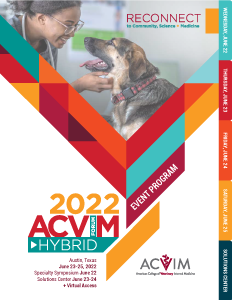Back
Please note, this session is not eligible for CE credit via on demand viewing. It is only available for CE credit if you attended the session live in person.
Research Report
Neurology
Long-term Outcomes of Canine Calvarial Multilobular Tumor of Bone Treated by Craniectomy
Thursday, June 23, 2022
10:00 AM – 10:30 AM CT
Location: ACC 16AB
CE: .5
- VM
Vishal D. Murthy, DVM, DACVIM (Neurology)
Assistant Professor
Washington State University
Pullman, Washington, United States
Research Report Presenter(s)
Abstract: Background: Calvarial multilobular tumor of bone (MLTB) is typically treated with surgical excision and various adjunctive therapies. However, survival and recurrence outcome data are lacking.
Hypothesis/Objectives: To describe the clinical features, imaging characteristics, surgical treatment, and long-term outcomes of dogs with calvarial MLTB.
Animals: 53 client owned dogs with histologically confirmed MLTB.
Methods: Retrospective case series of canine MLTB treated with craniectomy. Signalment, examination findings, advanced imaging findings, surgical technique, histological grade, and outcome (survival, recurrence) were recorded.
Results: Most dogs showed no neurological deficits (66.0%). Tumors commonly involved the frontal (30.4%) and parietal (29.4%) bones. Venous sinuses were frequently involved on imaging (45.1%) and in surgery (44.2%). Intraoperative complications (e.g.: hemorrhage, cerebral swelling) occurred in 24.5% of cases. Postoperative complications, occurring in 43.4% of cases, included aspiration pneumonia, seizures, and intracranial hypertension. Tumors were not routinely graded (56.6% ungraded), limiting evaluation. Incomplete surgical margins were identified on histopathology in 69.8% of cases and had a negative effect on time to recurrence (HR 9.6; 95% CI 1.6-89.3; P = 0.02), as did a history of preoperative biopsy (HR 4.0; 95% CI 1.150 to 15.93; P = 0.04). The use of adjunctive therapies had a positive effect on time to recurrence (HR 0.21; 95% CI 0.04-0.9; P = 0.04). Median survival time was 1088 days (range 0-3165 days) and median time to recurrence was 470 days (range 53-916 days).
Conclusions and clinical importance: Long-term remission and survival is possible with calvarial MLTB. Histological grading and margin evaluation should be routinely performed.
Hypothesis/Objectives: To describe the clinical features, imaging characteristics, surgical treatment, and long-term outcomes of dogs with calvarial MLTB.
Animals: 53 client owned dogs with histologically confirmed MLTB.
Methods: Retrospective case series of canine MLTB treated with craniectomy. Signalment, examination findings, advanced imaging findings, surgical technique, histological grade, and outcome (survival, recurrence) were recorded.
Results: Most dogs showed no neurological deficits (66.0%). Tumors commonly involved the frontal (30.4%) and parietal (29.4%) bones. Venous sinuses were frequently involved on imaging (45.1%) and in surgery (44.2%). Intraoperative complications (e.g.: hemorrhage, cerebral swelling) occurred in 24.5% of cases. Postoperative complications, occurring in 43.4% of cases, included aspiration pneumonia, seizures, and intracranial hypertension. Tumors were not routinely graded (56.6% ungraded), limiting evaluation. Incomplete surgical margins were identified on histopathology in 69.8% of cases and had a negative effect on time to recurrence (HR 9.6; 95% CI 1.6-89.3; P = 0.02), as did a history of preoperative biopsy (HR 4.0; 95% CI 1.150 to 15.93; P = 0.04). The use of adjunctive therapies had a positive effect on time to recurrence (HR 0.21; 95% CI 0.04-0.9; P = 0.04). Median survival time was 1088 days (range 0-3165 days) and median time to recurrence was 470 days (range 53-916 days).
Conclusions and clinical importance: Long-term remission and survival is possible with calvarial MLTB. Histological grading and margin evaluation should be routinely performed.

